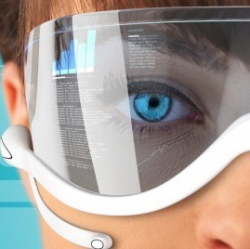
It came to light in 2008 that an Apple research team was working on a visual headset for the iPod. In recent months news has surfaced that a next generation super high res micro OLED display is ready to support new visual headsets coming to market later this year. The stunning miniature displays pack quite the punch with a resolution of 2560 x 2048. Since that news, we’ve reported on a Sony research team working on a video headset for a future PlayStation while noting that Google may want in on this new market as well. While the race is clearly on to get the first commercially successful video headset to market, Patent Bolt has discovered that Microsoft has been secretly working on a video headset since September 2010. A New Microsoft patent reveals that they’ve been working two styles of headset. The first relates to an aviation styled helmet aimed at Xbox gamers while the second resembles a pair of sunglasses for use with smartphones, MP3 players and other future devices. With Microsoft’s success with Kinect for gaming and beyond, it would appear to me that they might just have the edge in this race. Today’s report provides you with a few insights into one of Microsoft’s latest projects.
Microsoft’s Patent Background
Microsoft states that a compact display system may be coupled into goggles, a helmet, or other eyewear. These configurations enable the wearer to view images from a computer, media player, or other electronic device with privacy and mobility. When adapted to display two different images concurrently–one for each eye–the system may be used for stereoscopic display (e.g., virtual-reality) applications.
As the human eye can’t focus on images less than a few centimeters away, a compact display system may be configured to provide the display image as a virtual image–e.g., an image formed in a focal plane located more than a few centimeters from the eye. One challenge in this field is to form such an image using a compact, robust optical arrangement, which also provides suitable image resolution and fidelity
Microsoft’s Proposed Solution
One of Microsoft’s invention embodiments provides us with a look at a virtual-image projector. Technically speaking, the projector comprises a laser configured to form a narrow beam, first and second dilation optics, first and second redirection optics, and a controller. The first and second dilation optics each have a diffraction grating.
The first dilation optic is arranged to receive the narrow beam and to project a one-dimensionally dilated beam into the second dilation optic. The second dilation optic is arranged to receive the one-dimensionally dilated beam and to project a two-dimensionally dilated beam, which provides the virtual image.
The first and second redirection optics are each operatively coupled to a transducer. The first redirection optic is arranged to direct the narrow beam into the first dilation optic at a first entry angle. The second redirection optic is configured to direct the one-dimensionally dilated beam into the second dilation optic at a second entry angle. The controller is configured to bias the transducers to vary the first and second entry angles.
Microsoft’s Virtual Image Displays for Glasses
In Microsoft’s patent FIG. 1 shown below we see an example head-mounted display device (10) which is an example of video-display eyewear. Although the eyewear may closely resemble an ordinary pair of eyeglasses or sunglasses, the fact is that the device includes a pair of projectors (12A and 12B) which project virtual display images for view by a wearer. More particularly, the virtual display images are projected directly in front of the wearer’s eyes. To this end, the device includes a wearable mount configured to position the projectors a short distance in front of the wearer’s eyes.
In the illustrated embodiment, the wearable mount takes the form of conventional eyeglass frames (14). In one embodiment, each projector may project a 16:9 aspect ratio image that will appear to the wearer as if it were 21 inches in diagonal and viewed at arm’s length. The device also includes controller 16, which controls the internal componentry of the projectors in order to form the virtual display images.
